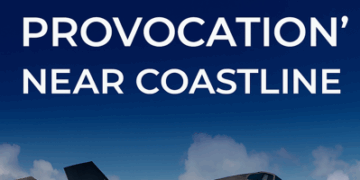Venezuela Accuses US
In a dramatic escalation of tensions between Caracas and Washington, Venezuela’s Defense Minister Vladimir Padrino announced on Thursday that five US F-35 fighter jets were detected flying just 75 kilometers off the country’s Caribbean coast. The incident, described as a “provocation,” has sparked renewed concerns over regional stability and the growing militarization of the Caribbean.
🛩️ Fighter Jets Detected Near Venezuelan Airspace
According to Padrino, the aircraft were flying at an altitude of 35,000 feet and a speed of 400 knots. They were detected by Venezuela’s air defense systems operating within the Maiquetía flight information region—a vast airspace that includes Venezuelan territory and extends into international airspace over the Caribbean Sea.
“They are combat aircraft. Combat aircraft that US imperialism has dared to approach the Venezuelan coast,” Padrino said during a televised address on state media.
The Defense Ministry confirmed that the jets were identified as F-35s, a fifth-generation stealth fighter used by the US military. The aircraft reportedly originated from Puerto Rico, where a unit of US Marines has been conducting amphibious landing exercises.
✈️ Civilian Aircraft Confirms Jet Presence
Adding to the gravity of the situation, the crew of an international airliner flying through the region reported visual contact with the US jets. The pilot relayed the sighting to Maiquetía air traffic controllers, corroborating the Defense Ministry’s radar data.
While the jets remained outside Venezuela’s 12-nautical-mile territorial boundary, officials argue that their proximity constitutes a deliberate act of intimidation.
🌍 Strategic Context: US Military Presence in the Caribbean
The jet sightings come amid heightened tensions between the United States and Venezuela. In recent weeks, Washington has deployed several warships to the Caribbean, officially as part of a mission to combat drug trafficking. However, Venezuelan officials claim the true objective is regime destabilization.
“We had never seen this deployment of aircraft, which we know are stationed in Puerto Rico, of the F-35 class,” Padrino said. He accused the US of using military exercises as a cover for surveillance and psychological warfare.
Two White House officials previously told CNN that the US would send 10 F-35s to Puerto Rico. The deployment is part of a broader strategy involving joint training exercises with regional allies.
⚔️ Recent US Strikes Raise Alarm
Venezuela’s concerns are compounded by recent US military strikes targeting boats allegedly involved in drug trafficking. At least four vessels were destroyed, resulting in the deaths of over a dozen suspected traffickers. The US has not released concrete evidence confirming the criminal status of those killed.
Venezuelan officials argue that these operations lack transparency and could be used to justify future incursions into sovereign territory.
🗣️ Diplomatic Response and International Outreach
Following the jet sightings, Venezuela’s Foreign Minister Yván Gil reiterated that the country is not seeking conflict with the United States. In an interview with CNN, Gil emphasized the importance of dialogue and mutual respect.
“We are committed to peace, but we will not tolerate violations of our sovereignty,” Gil said. He called on international organizations to monitor US military activity in the region and urged neighboring countries to remain vigilant.
🔍 Awaiting US Clarification
As of Friday evening, the US Department of Defense has not issued an official statement regarding the incident. CNN has reached out for comment and requested flight path data to verify the exact location of the jets.
Analysts suggest that the US may downplay the event, citing international airspace rights. However, the symbolic impact of flying advanced fighter jets near a politically sensitive region cannot be ignored.
🛡️ Venezuela’s Air Defense Capabilities
Venezuela has invested heavily in radar and missile systems over the past decade, primarily sourced from Russia and China. The country’s air defense network includes long-range surveillance radars and surface-to-air missile batteries capable of tracking high-altitude aircraft.
While Venezuela lacks the technological parity to challenge US air superiority, officials claim their systems are sufficient to detect and respond to incursions.
🌐 Regional Reactions and Strategic Implications
Latin American governments have remained largely silent on the incident, though some analysts warn that increased US military activity could destabilize the region. Countries like Cuba and Nicaragua have historically supported Venezuela’s stance against US intervention.
“This is not just about Venezuela. It’s about the balance of power in the Caribbean,” said Dr. Luis Martínez, a geopolitical expert at the University of Bogotá. “The presence of F-35s sends a message to every government in the region.”
📜 Historical Context of US-Venezuela Tensions
Relations between the US and Venezuela have been strained for decades, particularly since the rise of Hugo Chávez and his successor Nicolás Maduro. Sanctions, diplomatic expulsions, and accusations of election interference have defined the bilateral relationship.
The latest jet incident adds to a long list of confrontations, including naval standoffs and cyber warfare allegations.
✅ Conclusion: A New Flashpoint?
The detection of US fighter jets near Venezuela’s coast marks a new flashpoint in an already volatile relationship. While the aircraft remained in international airspace, their presence so close to Venezuelan territory has been interpreted as a calculated provocation.
Defense Minister Padrino’s warning—“We are watching you… this does not intimidate us”—underscores the seriousness with which Caracas views the incident. As the region braces for potential fallout, the international community will be watching closely to see whether diplomacy or escalation prevails.
Sources: CNN, Venezuelan Defense Ministry, US Department of Defense, University of Bogotá




















Comments 1